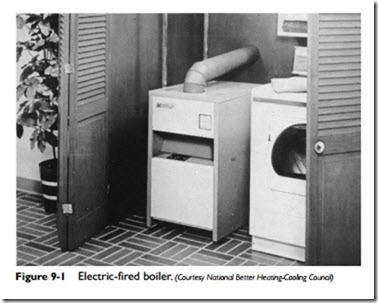Different heating systems use electricity as a source of heat. Each of them employs one or more of the following methods of heat transfer:
1. Radiation
2. Convection
3. Forced air
Radiation is the transmission of heat energy by means of electro- magnetic waves (infrared light). In other words, the heat is transferred directly from the surface of the heating element to the people, objects, and furnishings in the room without significantly heating the air.
Convection takes place after the temperature of air is increased by contact with a heated surface. As the air becomes warmer, it becomes lighter and rises. When it touches a cooler object, it gives up some of its heat to that object, becomes cooler and heavier, and sinks, completing the circulation of the air in the space. Now note the difference between radiation and convection. In the radiation method of heat transmission, the heat energy passes through the air to the individual or object in much the same way that the sun transfers its heat to earth through space and through the atmosphere. The air is not used as the medium of heat transfer. The surfaces are warmed, and the air picks up heat from these surfaces (convection), not directly from the infrared radiation passing through it from the heating element.
In the forced-air method of heat transmission, the heated or conditioned air is circulated by motor-driven fans integral to the heating unit or included elsewhere in the system. The heated air is forced directly into the room (as in the case of a wall heater) or through a duct system from a centrally located furnace (central forced-warm-air heating systems).
Central Hot-Water Systems
Some central hydronic systems (i.e., forced-hot-water heating systems) use electric-fired boilers as the heat source. These boilers (Figure 9-1) are compact units consisting of an insulated steel or
cast-iron generator with replaceable immersion heating elements. The expansion tank, circulating pump, valves, and prewired controls are included within the boiler package, and the entire unit is assembled at the factory (Figure 9-2).
An electric-fired boiler is compact, generally having a water capacity of only 2 or 3 gal. Some electric-fired boilers are small enough to be hung on a wall in the home. The small size is possible because water has a much higher heat-carrying capacity than air, and the electric elements are immersed directly in the water. This not only saves space but provides very rapid heating of the water because almost all the heat produced by the elements is transferred directly to the water. The heated water is piped directly to the room convectors, where its stored heat is delivered to the air. Distribution of the water can be easily controlled by zone valves under the control of separate zone thermostats.
The controls for an electric boiler are similar to those found on boilers (e.g., oil- and gas-fired) in other central heating systems. The basic controls are:
1. A low-voltage thermostat
2. Pressure and temperature limit controls
3. Relay and sequence controls
4. Circulating pump controls
The circulating pump is activated by the low-voltage thermostat. Boiler overheating and pressure buildup is controlled by the boiler high-limit controls and the pressure-temperature relief valve.
More detailed descriptions of electric-fired boilers and their controls are found in other chapters of this book (see, for example, the section on electric-fired boilers in Chapter 15, “Boilers and Boiler Fittings”).
For information about the piping system used in electric hydronic heating, read the appropriate sections in Chapter 7, “Hot-Water Heating Systems” and in Chapters 8 and 9 of Volume 2.
Cooling for an electric hydronic system is generally provided by individual room air conditioners (i.e., through-the-wall units) or by chilled water pumped from a central refrigeration unit. The latter installation is usually found in multifamily structures, such as apartment buildings.

